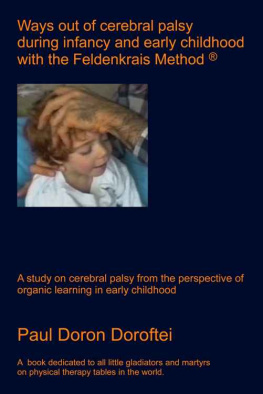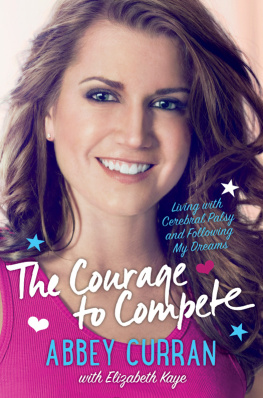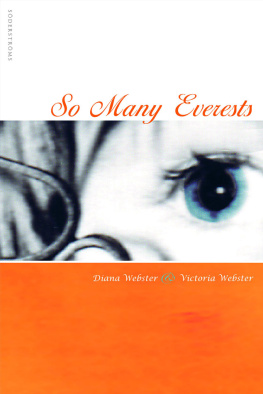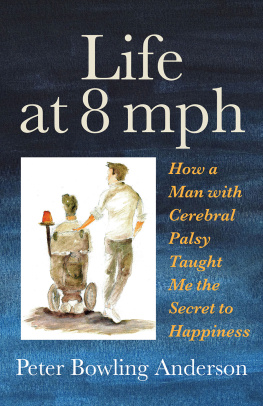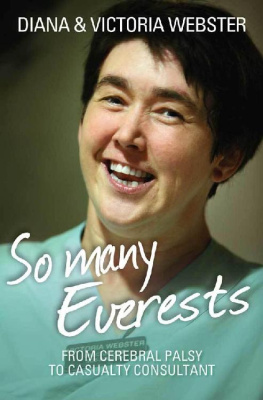Ways out of Cerebral Palsy during Infancy and Early Childhood with the Feldenkrais Method
A Study on Cerebral Palsy from the Perspective of Organic Learning in Early Childhood
For my mother, who refused to allow any orthopedic surgeon to play with my tendons, muscles, or joints.
This book is also dedicated to all little gladiators and martyrs on physical therapy tables in the world.
To my master, Dr. sc. Mosh Feldenkrais.
Preface
In one way, I think being an initiator that I have the meansand actually today I can show that there is enough knowledge that can be used already to improve things which are beyond the ken of humanity.
Mosh Feldenkrais, Physics and My Method
In this book I intend to reveal as well as clarify a hidden fact of life that has yet to enter our collective awareness. Once recognized, this elusive, obvious fact will open perspectives for our own life and the lives of others, showing in a new light the responsibilities we assume for our actions in every field of human endeavor, be it education, medicine, politics, or daily personal interplay.
The great skill of Mosh Feldenkrais and, as he said, the most valuable achievement of his method, judging by its consequences, was to help even handicapped infants understand abstractions such as speed, balance, and direction by means of concrete experience. In this sense and in accordance with the purpose of this book, I aim for simplicity and clarity, that is, absence of ambiguity toward the understanding of my subject matter. To this end, I work by way of everyday, concrete examples, and as few verbal explanations as possible, which all too often contribute to misinterpretations, misunderstandings, and confusion.
I owe the basic idea for this book to an ant, which, by its presence and industrious activity in my apartment in Tel Aviv sometime in the 1970s, contributed significantly to my understanding of the phenomenon of life and, with it, my understanding of the nucleus and the essence of Moshs approach to life and the aim of his method, which is summarized in his most-used saying: When I know what I am doing, I can do what I want. In other words, the Feldenkrais Method helps us as human beings to act more in accordance with our own intentions and not be directed by unconscious, parasitic behavioral patterns acquired through personal experience with the environment. The basic idea of intentions is also the foundation for the Feldenkrais Method and its significance as an agent of liberation in our striving for a better quality of life.
While doing one of Moshs Awareness Through Movement lessons on the floor of my Tel Aviv apartment, I noticed, a few feet from me, an unusually large grain of rice migrating with jerky movements, arduously but persistently, in a precise direction. From the perspective of my position, the grain of rice appeared to be moving autonomously for more than a minute before I discovered the thin little legs of the ant, and the strange mix of astonishment and curiosity that had held me captive turned into a feeling of love and compassion for the tiny creature struggling to carry that unwieldy grain of rice. The surrealistic landscape of the initial moment and the unforeseen solution to the riddle of the self-propelled grain of rice had a far-reaching effect on my understanding of the difference between moving and being moved , between an intended action and one that occurs without intentionthe difference delineating a living being from a lifeless object.
Through the following examples, I will attempt to illustrate the decisive difference between the states of moving and being moved.
1. The windows of our apartment are open. It is a stormy day out there, and the curtains are flying in the drafta familiar picture that does not give particular cause for concern. Yet how would we react if the curtains began to fly vigorously on their ownwith windows closed? I think nobody would stay in that room for very long. Why? Because the lifeless object, the curtain, would behave counter to our experience, passing over the threshold between lifeless and alive, by its own intended action.
2. As a tree, wood behaves like living matter, in contrast to firewood or wood in the form of a piece of furniture. The tree will let us know of its living state through certain chemical and physical processes that do not exist in a piece of furniture (and are therefore termed biochemical and biophysical). The tree will turn toward the light, grow, make oxygen from atmospheric carbon dioxide and release it, take up nutrition from the earth, exude moisture, and manufacture flowers and seeds.
Wood as furniture will engage in no such activities, although it may respond to a limited number of physical changes in the environment by expanding or contracting with the rise and fall of temperature and humidity in its immediate surroundings. Unless chemically treated, dead wood deteriorates by biochemical means or through the action of living beings such as worms, termites, or wood-eating ants, who act according to their own intentions.
3. Intention as the decisive factor in the behaviors differentiating living beings from objects plays a role in many a thriller film or story, where it is used as a means of subconsciously increasing tension and creating false expectations. When the hero of the story, with whom we identify, finds himself in an eerie place, perceived by him as dangerous, we experience every change in his and our surroundings as a source of fear because of the unpredictability of the living beings we assume to be lurking in the darkness, ready to strike, be they humans, werewolves, snakes, or weapons guided or constructedin other words, intendedto destroy us.
If, on the other hand, a door slams shut, or an empty can rolls noisily across the floor, and we happen to realize that the door was shut by a gust of wind, and the can rolled because we touched it with our foot, we recognize these happenings as accidentalin other words, unintendedand our initial fear quickly subsides. The fear was awakened by an obscure intent that was perceived as a threat. Thats why here, also, intention can be regarded as a trademark of life expression.
4. In the end, one can ask, what is the purpose of political killing? What does the killer intend to achieve? What distinguishes a living being from one who has ceased to live, one who is lying before us dead?
The answer is that in the dead state, the being has lost the option of having intentions. This is also the reason why a totally obedient, indoctrinated person is the ideal subject in any dictatorship. Such a person has no intentions of colliding with the purpose of the system. Throughout history, the maintenance of tyrannies and the associated continual suppression of differences of opinion have cost the lives of untold millions.
Every system, whether political or organic, has self-organization as a prerequisite because all components must act in coordination and in accordance with an overriding purpose; they must, as Mosh Feldenkrais liked to put it, collaborate in an organized way. In a closed, totalitarian system, any individual entity or unit that behaves independently, be it a cancer cell or a political activist, is perceived as threatening and therefore eliminated. In the biological organization of higher animals, both the police and the exterminator are represented by the immune system. If the immune system fails to eliminate a cancer or a dangerous virus, the organism dies.
An optimally functioning organism realizes its intentions with minimal loss of energy. In other words, it reduces and possibly eliminates parasitic activity patterns that limit or block certain functions relevant to its intent. This paradigm is attended to rigorously in technological fields, for example, in the design of increasingly energy-efficient and reliable jet engines.

